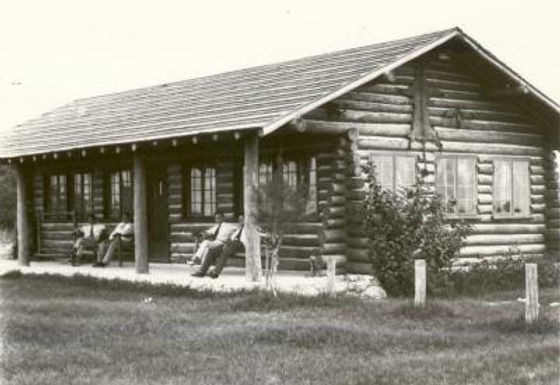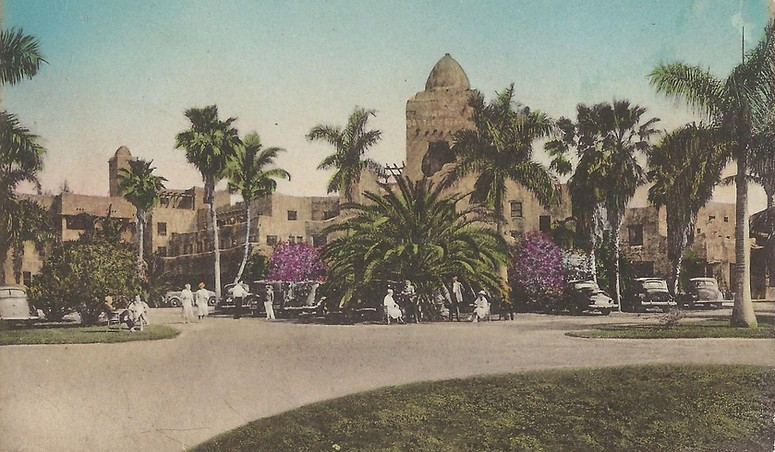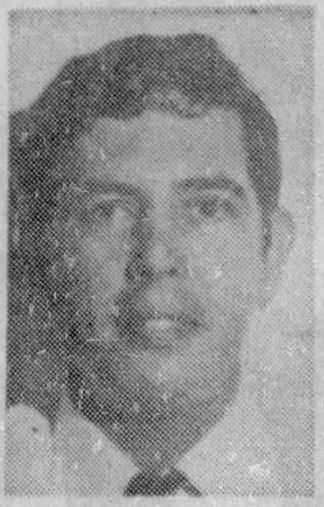Our history
Miami Springs was founded during the 1920s land boom by Glenn Hammond Curtiss, known as “The Father of Naval Aviation,” and James Bright. Named initially Country Club Estates, it was one of Florida’s first planned communities, alongside Coral Gables and Opa-locka. Like its counterparts, the city was designed with a distinct architectural theme to create a unique atmosphere.
Inspired by the Pueblo Revival style, which originated in the American Southwest, particularly New Mexico, Miami Springs adopted elements of Pueblo and Mission-style architecture. Two of its most iconic landmarks, the original Hotel Country Club, was even designed to resemble a traditional Pueblo village, along with the Curtiss Mansion, once owned by the city founder.
In 1930, the city was renamed Miami Springs in honor of a natural spring in the area, which provided fresh water to parts of Miami until the mid-1990s.

1916
the land boom
Aviation pioneer Glenn H. Curtiss and his partner, James H. Bright, purchase 17,000 acres of land, encompassing areas that would later become Miami Springs, Hialeah, and Opa-locka, during what was called the "land boom" of the 1920's.
The Bright Brothers Ranch was owned by James and J.W. Bright. In 1918 Glenn Curtiss bought our J.W. Bright's share of the Bright Brothers Ranch and formed the Curtiss Bright Ranch with James Bright. Curtiss and Bright bought more acreage, expanding the Curtiss Bright Ranch. It may have reached 17,000 acres.
Picture: James Bright, Glenn Curtiss and resident Art Stanton (the secretary-treasurer of the Curtiss Bright Company)

1922
Seminoles & settlers
In 1922, the Curtiss-Bright Company expanded the Miami-Hialeah Golf Course further west after raising $75,000 in bonds. To bring the vision to life, many Seminole Indians from Big Cypress Swamp were hired to help develop the course, with Seminole leader Willie Willie overseeing the grass planting. This early collaboration between developers and the Seminole people played a key role in shaping the lush greens of what would later become the Miami Springs Golf Course.


Seminole leader
Willie Willie
1923
the golf course
On January 1, 1923, Miami’s very first golf course, the Miami-Hialeah Golf Course (now known as the Miami Springs Golf Course), opened its doors to the community. More than 100 golfers came out to play.
At first, only the front nine holes were ready, but the back nine was set to open within two months. To celebrate the grand opening, families and golf lovers could play for free during the first 10 days.
This beautiful course soon became a favorite gathering place for families, friends, and golf enthusiasts, making Miami Springs an important part of Florida’s golfing history.

1924
warren pony
swing bridge
This historic steel off-center pivot "bob tail" swing bridge, constructed on-site in 1924, has played a vital role in the development of the Hialeah-Miami Springs area. Spanning the Miami Canal, the bridge connects Okeechobee Road in Hialeah to Curtiss Parkway in Miami Springs. As the first major bridge linking both banks of the canal, it has remained a crucial transportation route for a century.
Pioneers Glenn H. Curtiss and James H. Bright, founders of Hialeah and Miami Springs, were instrumental in the bridge's creation, even providing financial assistance to Dade County to support its construction. Today, this remarkable engineering feat stands as a testament to the region’s early development and continues to serve travelers just as it did nearly a century ago.


1924
the hunting lodge
Built-in 1924 by Glenn Curtiss, this
one-story log cabin, known initially as the Hialeah Shooting Park, was a gathering place for local shooting and archery enthusiasts. From 1926 to 1933, the rustic hunting lodge took on a new role, serving as an elementary school, the smallest in the Dade County public school system. This historic structure remains a testament to the community's early days, reflecting its adaptability and rich heritage.

1925
In the early days of Country Club Estates (now Miami Springs), a stately home stood proudly at 27 Hunting Lodge Drive. Built in 1924 by the Curtiss Bright Company, this home was one of the four original houses in the budding community. It belonged to J. Alden Michael, a respected realtor and longtime friend of aviation pioneer Glenn Curtiss.
By 1926, Michael had established his real estate office in the Clune Stadnik Engineering building at the Circle, playing a key role in shaping the development of the area. Alongside his wife, Minnie, the couple became known as the first residents of Country Club Estates, marking the beginning of a thriving neighborhood that would grow into the vibrant community of Miami Springs.
1st residents of
country club estates
.jpg)
1925
the
osceola
apartments
On January 25, 1925, John M. O'Connor was permitted to construct an apartment building in the growing Country Club Estates development. The Osceola Apartments project was designed to provide modern living accommodations for the expanding community.
By January 1, 1926, construction was complete, and the 18 "family homes," as they were called, were ready for new residents. These apartments quickly became sought-after rentals, offering comfortable living at a rate of $75 per month, a reflection of Country Club Estates' promising future.

1925
pure water
In 1925, engineers working for aviation pioneer Glenn Curtiss discovered an abundant source of pure water beneath the Miami-Hialeah Golf Club. the Curtiss-Bright Company transferred the water rights from the golf course to the City of Miami. They also granted easements for wooden aqueducts—still running beneath the golf course—extending along Curtiss Parkway to the Hialeah "Preston Water Treatment Plant." The freshwater wells on the golf course then became the city's first organized water supply system, replacing the old method where residents relied on individual wells.

1925
Glenn Curtiss designed this charming two-story Pueblo-Mission style mansion, as his personal residence. Overlooking the eastern perimeter of the golf course, it was the largest of the Pueblo-themed homes built by the Curtiss-Bright Company as part of the Country Club Estates development. This distinctive home remains a significant landmark, reflecting Curtiss’s vision and architectural influence in the area.
the mansion

1925
the heart of the city
In 1925, the Circle began to take form, quickly becoming a lively gathering place for the growing community. Photographs from that time capture its original bandstand, where families and neighbors came together for performances, celebrations, and social events.
Over the years, the Circle has evolved with various updates. In the 1970s, a fountain was added to the center, though it remained only for a short time. Despite these transformations, the Circle has continued to serve as a beloved landmark, a place where residents connect, and a lasting symbol of Miami Springs' rich heritage.

.jpg)
1925
The
Resilient Clune-
Stadnik Building
One of the first buildings constructed in Miami Country Club Estates, the Clune-Stadnik Building is the only remaining structure from the original “civic center” envisioned by Glenn Curtiss. Built in 1925, this historic landmark has withstood the test of time, surviving hurricanes, floods, fires, burglaries, and buy-out attempts.
Located "on the Circle", the building stands with an unmistakable presence, a symbol of the city’s rich history. Originally built and occupied by the Curtiss-Bright Company, it served as the office of Chief Engineer Daniel Clune, playing a vital role in the early development of Miami Springs. Today, it remains a cherished part of the community’s heritage.

1925
the nightclub
One of the largest nightclubs in Dade County, the Arabian Nights Cabaret, once stood on the third block of what would later become Westward Drive in Miami Springs. This glamorous venue opened its doors on December 29, 1925, offering entertainment and nightlife to the growing community. However, its time was short-lived, as the Great Miami Hurricane of 1926, devastated the club, bringing an abrupt end to its brief, but vibrant existence.

1926
the birth of a town
On the evening of August 23, 1926,
75 registered voters gathered at the Curtiss-Bright Administration Building to make history. In a unanimous vote, they officially incorporated the Town of Country Club Estates, laying the foundation for what would later become Miami Springs. This moment marked the beginning of a thriving community,
built on the vision of
Glenn Curtiss and James Bright.

1926
the hurricane
The Great Miami Hurricane of 1926 made landfall on September 18th. It was a category 4 hurricane with winds reaching 145 mph causing catastrophic damage across South Florida. The hurricane was one of the deadliest in U.S. history, killing over 370 people and leaving thousands homeless. It marked the beginning of a long economic downturn for South Florida.

1927
hotel
country club
Construction of the Hotel Country Club in Miami Springs, began in 1927. The hotel was designed in the Pueblo Revivial style by architect Bernard E. Muller and was intended to serve as a luxurious centerpiece for the Country Club Estates development.

1927
the flood
In 1927, heavy rains caused severe flooding in Miami Springs, submerging streets, homes, and businesses. As water levels rose, residents used boats to navigate the flooded areas, and many were forced to evacuate. The disaster highlighted the need for better drainage and flood control systems, prompting future improvements to protect the growing community. Despite the devastation, Miami Springs rebuilt and strengthened its infrastructure, demonstrating the city's resilience in the face of natural challenges.

1929
A New Era for
the Hotel
Amid the 1929 economic downturn, Glenn Curtiss sold the hotel to his friend, health pioneer Dr. John Harvey Kellogg, for "$10 and other valuable considerations," transforming it into a health spa.
Despite the era’s racial restrictions, the deed included a rare provision allowing guests of all races, a progressive stance at the time. Dr. Kellogg lived and worked at the Miami Battle Creek Sanitarium, where he treated patients, developed soy-based foods, wrote extensively, and raised his adopted family, leaving a lasting mark on the community.

1930
a lasting legacy
On July 23, 1930, aviation pioneer and
Miami Springs founder Glenn Curtiss passed away at the age of 52 due to complications from an appendicitis surgery in
Buffalo, New York. Though his life was cut short, his impact on aviation, urban development, and innovation endured. As a visionary entrepreneur, he helped shape Miami Springs, Hialeah, and Opa-locka, leaving behind a legacy of progress, ingenuity, and community building that continues to define the region today.

1936
a community’s first
place of worship
Located at 301 Westward Drive, the First Presbyterian Church of Miami Springs was built in 1936, making it the first church in the city. Designed in the Mission style, it features a small bell tower that adds to its historic charm.
To fund its construction, church members came together, purchasing cement blocks for just 10 cents each, demonstrating the community’s dedication. The original church building still stands at the corner of Westward and Morningside Drives, a lasting symbol of faith and unity in Miami Springs.

1937
a Community
milestone
The construction of Miami Springs Elementary School was a Works Progress Administration (WPA) project funded by the federal government. Work began on
October 30, 1936, and the school officially opened on November 7, 1937.
Designed as a one-story, U-shaped building, it featured 12 classrooms. The project received $25,000 in federal funding, with an additional $3,000 from the school board, bringing the total construction cost to $28,000.
This historic photo, taken on March 28, 1938, captures the school's first kindergarten class, marking the beginning of its long-standing role in the Miami Springs community.


1937
Miami Springs
Law Enforcement
In 1937, the Miami Springs Police Department was a small but highly efficient team led by Town Marshal Walter D. Kniffin. The force included four officers—two on duty during the day and two at night—who patrolled the town in a single car equipped with a radio (courtesy of a contract with the Miami Police radio station), ensuring a response time of just two minutes. Key officers, including Hugh Frank, E.P. Lott, L.J. Cropper, and Hoyt Buxton, kept the community safe. Later, Town Marshal Kniffin joined the U.S. Marines in World War II and tragically lost his life in the Battle of Iwo Jima. (Photo: Looking east with the Curtiss Bright Administration Building in the background.)

1939
the water tower
In 1939, the Miami Springs Water Tower was built to support the city’s growing residential and commercial needs. The 135-foot-tall structure held 100,000 gallons and was strategically placed of what is now east of the Lion’s Club turning basin, just north of N. Royal Poinciana Blvd. The tower played a crucial role in providing water pressure to homes and businesses, helping Miami Springs develop into a thriving town. The picture was taken in 1952, when a 12-year-old boy climbed to the top of the tower, sparking a tense moment as his father scaled the structure to bring him down safely. As Miami Springs' water infrastructure modernized, the tower became obsolete and was demolished around 1960. The vacant property was later auctioned off by the town in 1961, bringing an end to this once-vital landmark.

1939
the women's club
Founded in May 1939, the Miami Springs Women's Club quickly became a vital charitable, educational, and social force in the community. One of its early projects was establishing the town’s first public library, which initially housed 171 donated books in a small back room of the Municipal Building—books contributed by residents at a Library Tea held at the Miami Battle Creek Sanitarium (now Fairhavens). To support the library, founding member Lena Pearl Curtiss Wheeler donated two lots, valued at $20,000, in memory of her mother and her late husband's mother. Funds to build the structure were raised by the club through various fundraisers during the 1940s.
1942
world war II
During World War II, Miami Springs demonstrated remarkable community spirit. The Miami Battle Creek Sanitarium—later known as Fairhavens—was rented to the Air Transport Command and served as a vital recovery facility for military personnel. At the same time, Miami Springs Elementary became a hub of patriotic activity. Students, teachers, and the PTA operated a Red Cross dressing room, crafted surgical dressings, collected salvage, and tended a victory garden, while also serving as a training site for air raid wardens. These collective efforts underscored the town's unwavering commitment to supporting the war effort on the home front.
This 1943 photo features the Miami Springs Elementary School PTA principal and officers: top row (from left) Mary Kniffen, school principal Mrs. Era May Furr, Mrs. James, and Mrs. Elizabeth Madeira; bottom row Mrs. Hearh, Peggy Filer, Mrs. Madeleine Robinson, and Mrs. Gus Halwardson. Mary Kniffen’s husband, Walter Kniffen—who served as Miami Springs Chief of Police—was killed in action on February 23, 1945, during the Battle of Iwo Jima.


1950
the rec center
In the early 1950s, the building at 401 Westward Drive served as the Miami Springs Recreation Center—a bustling community hub for everything from teen dances and classes to club meetings and even a voting precinct. Locals fondly remember summer days spent on its unique stilts and playing tetherball. In 1952, tennis and shuffleboard courts were added to further energize the space. Then, in 1955, after a new pool and gym opened farther west, the building transformed into the Miami Springs Library. Basketball games were a common sight on the courts behind the building into the 1960s, until those courts were replaced with additional tennis and a racquetball court. In 1965, the library officially became part of the Dade County Library System, cementing its role as a cherished community landmark.

1962
Officially a city
In the early 1960s, Miami Springs experienced a boom thanks to the rapid expansion of the airline industry at Miami International Airport. As airline employees flocked to the area, the town saw a surge in construction and an influx of new residents. This growth set the stage for a historic decision in 1962: by a narrow vote of 841 to 826, the Town of Miami Springs was incorporated as a city. Shortly thereafter, in a vote of 1268 to 776, residents removed parking meters from city streets, marking another unique milestone in the city’s evolving character.

1964
once a hawk,
always a hawk
In 1964, Miami Springs Senior High School opened with a record-breaking $2 million price tag—making it one of Florida's largest and most advanced schools. It was the first school in the state to be fully air-conditioned, including its gymnasium and auditorium, and was hailed by the Miami Herald as the "school system’s best equipped and most beautiful." Built to relieve overcrowding at Hialeah High, the school served southern Hialeah, Miami Springs, Virginia Gardens, and Medley. Known for their mascot the Golden Hawk, the school has produced notable alumni like Florida State Senator Manny Diaz, NFL star
T.Y. Hilton, and World Series Champion
John Cangelosi. Though originally designed for 2,500 students, rapid population growth led to chronic overcrowding, at times peaking at 4,750. Today, however, MSSH has transformed into a top-rated A magnet school with a more manageable enrollment of around 1,500, standing as a testament to the community's resilience and commitment to educational excellence.

1969
a bold vision
and a costly lesson
In 1964, council member and former mayor R.B. Fordyce dreamed up a dazzling fountain for Miami Springs. Despite his passionate pitches, the idea was repeatedly outvoted—until persistence won in 1968. Construction began in April 1968, and by September 1969 the fountain was complete, with a formal dedication following in March 1970. The project, however, was not without controversy; engineering contracts and cost overruns sparked heated debates. The biggest surprise came after completion: what was promised to cost under $5,000 a year ended up costing between $20,000 and $30,000. Ultimately, the fountain shone for only a short time before it was taken down, leaving behind a memorable, if costly, chapter in Miami Springs history.

1971
a fallen hero
Devoted to serving his community, Richard worked as a firefighter for a year and a half while saving for his continued education. On October 12, 1971, while in route to a call from Dade County Fire Station 7, tragedy struck when the snorkel truck he was riding in collided with a car, rolled over, and claimed his life. Today, a commemorative plaque at Fire Station 2, located at 6460 NW 27th Ave, stands as a lasting tribute to his sacrifice. His legacy of courage and dedication continues to inspire all of Miami Springs as we honor our past and look toward the future.


1976
the rhodes brothers
At Miami Springs' 50th Anniversary Parade on Westward Drive, the unforgettable Rhodes Brothers—Tom, Eddie, and John—captivated the crowd as they were driven by the charismatic Tex Ziade. Originating from Columbus, Ohio, the Rhodes family moved to South Florida in the 1960s and quickly became one of our community’s most cherished groups. They graced national TV shows like Johnny Carson, Merv Griffin, and Mike Douglas, appeared on countless telethons, parades, festivals, and even ran their own club at the Merchandise Mart near Miami International Airport. Though only John Rhodes remains today, their legacy continues to shine brightly in the history of Miami Springs.

1977
a winter miracle in
springs
On an unforgettable January morning, Miami Springs was transformed into a magical winter wonderland as an arctic cold front swept down the Florida coast. Between 8 a.m. and 9:30 a.m., delicate snowflakes began to fall across Broward and Miami-Dade, even reaching as far south as Homestead before melting away. With the high temperature lingering at a chilly 47°F and dips into the 30s, our vibrant community experienced a rare and exciting phenomenon. In one memorable photo, our very own Mike (son of celebrated local historian Ken Wilde) is caught joyfully scraping snow off our car’s hood on Raven Ave to craft a playful snowball. Though the snowfall was brief, its enchanting magic has become a beloved chapter in the history of Miami Springs, sparking wonder in our community for years to come.



